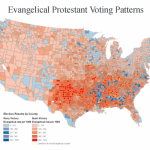The United States has a long history as a land of religious freedom and diversity. The First Amendment of the U.S. Constitution guarantees the free exercise of religion, stating that, “Congress shall make no law respecting an establishment of religion, or prohibiting the free exercise thereof.” This religious freedom in turn gave rise to religious diversity and pluralism in America.1 Religion and religious worship play an important role in the lives of Americans practicing a variety of different faiths. According to the Baylor Religion Survey, 2005, 93 percent of Americans believe in God in some capacity, with 65.8 percent having no doubts that God exists. The American National Election Studies (2004), found that 77 percent of respondents considered religion to be an important part of their life.2Immigration has also always been an important part of American history, and for many groups, immigration was strongly tied to religious reasons. The Pilgrims and Puritans came to the United States for the freedom to worship their own form of Christianity, and many Jews fled to the United States as a result of religious persecution; however, even groups emigrating from their homeland for other reasons, brought their traditions and religion along with them.
The religiosity of the United States is particularly interesting as it is deeply intertwined with social and political issues. Nearly 42 percent of Americans believe that political leaders should rely on religious beliefs in making policy decisions, and 62.5 percent of Americans believe religious leaders should try to influence politicians. Lynn Bridges believes that in terms of religion and race, “America is developing a workable pluralism.”3 Despite this, it is thus unsurprising that there are strong feelings about religious belief, as well as tensions, and stereotypes surrounding religion in the United States. Because of the unique religious landscape and religiosity of the United States, I decided to use GIS first, to analyze whether or not there is a spatial pattern to the distribution of religions across the United States, and second, to analyze socioeconomic and demographic trends along religious lines in the United States by examining a small selection of locations with high concentrations of particular religious groups.
1 Eck, Diana (2001) A New Religious America: How a “Christian Country” Has Become the World’s Most Religiously Diverse Nation. New York, New York: HarperCollins
2 All statistics from The Association of Religious Data Archives QuickStats (www.thearda.com)
3 Bridges, Lynn (2006). The American Religious Experience: A Concise History. Lanham, Maryland: Rowman & Littlefield Publishers
4http://www.terraseer.com/products/stis/help/Statistics/LM/About_Anselins_Local_Moran_statistic.htm
5 http://zappa.nku.edu/~longa/geomed/states/localmoran/localmoran.html
